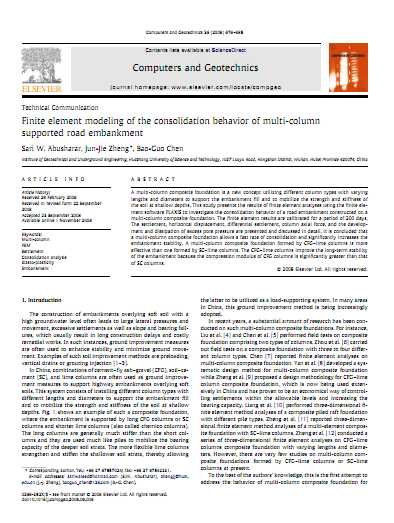Finite element modeling of the consolidation behavior of multi-column

Technical Communication
Finite element modeling of the consolidation behavior of multi-column
supported road embankment
1. Introduction
The construction of embankments overlying soft soil with a
high groundwater level often leads to large lateral pressures and
movement, excessive settlements as well as slope and bearing failures,
which usually result in long construction delays and costly
remedial works. In such instances, ground improvement measures
are often used to enhance stability and minimize ground movement.
Examples of such soil improvement methods are preloading,
vertical drains or grouting injection [1–3].
In China, combinations of cement–fly ash–gravel (CFG), soil–cement
(SC), and lime columns are often used as ground improvement
measures to support highway embankments overlying soft
soils. This system consists of installing different column types with
different lengths and diameters to support the embankment fill
and to mobilize the strength and stiffness of the soil at shallow
depths. Fig. 1 shows an example of such a composite foundation,
where the embankment is supported by long CFG columns or SC
columns and shorter lime columns (also called chemico columns).
The long columns are generally much stiffer than the short columns
and they are used much like piles to mobilize the bearing
capacity of the deeper soil strata. The more flexible lime columns
strengthen and stiffen the shallower soil strata, thereby allowing
the latter to be utilized as a load-supporting system. In many areas
in China, this ground improvement method is being increasingly
adopted.
In recent years, a substantial amount of research has been conducted
on such multi-column composite foundations. For instance,
Liu et al. [4] and Chen et al. [5] performed field tests on composite
foundation comprising two types of columns. Zhou et al. [6] carried
out field tests on a composite foundation with three to four different
column types. Chen [7] reported finite element analyses on
multi-column composite foundation. Yan et al. [8] developed a systematic
design method for multi-column composite foundation
while Zheng et al. [9] proposed a design methodology for CFG–lime
column composite foundation, which is now being used extensively
in China and has proven to be an economical way of controlling
settlements within the allowable levels and increasing the
bearing capacity. Liang et al. [10] performed three-dimensional finite
element method analyses of a composite piled raft foundation
with different pile types. Zheng et al. [11] reported three-dimensional
finite element method analyses of a multi-element composite
foundation with SC–lime columns. Zheng et al. [12] conducted a
series of three-dimensional finite element analyses on CFG–lime
columns composite foundation with varying lengths and diameters.
However, there are very few studies on multi-column composite
foundations formed by CFG–lime columns or SC–lime
columns at present.
To the best of the authors’ knowledge, this is the first attempt to
address the behavior of multi-column composite foundation for
Download
*

Technical Communication
Finite element modeling of the consolidation behavior of multi-column
supported road embankment
1. Introduction
The construction of embankments overlying soft soil with a
high groundwater level often leads to large lateral pressures and
movement, excessive settlements as well as slope and bearing failures,
which usually result in long construction delays and costly
remedial works. In such instances, ground improvement measures
are often used to enhance stability and minimize ground movement.
Examples of such soil improvement methods are preloading,
vertical drains or grouting injection [1–3].
In China, combinations of cement–fly ash–gravel (CFG), soil–cement
(SC), and lime columns are often used as ground improvement
measures to support highway embankments overlying soft
soils. This system consists of installing different column types with
different lengths and diameters to support the embankment fill
and to mobilize the strength and stiffness of the soil at shallow
depths. Fig. 1 shows an example of such a composite foundation,
where the embankment is supported by long CFG columns or SC
columns and shorter lime columns (also called chemico columns).
The long columns are generally much stiffer than the short columns
and they are used much like piles to mobilize the bearing
capacity of the deeper soil strata. The more flexible lime columns
strengthen and stiffen the shallower soil strata, thereby allowing
the latter to be utilized as a load-supporting system. In many areas
in China, this ground improvement method is being increasingly
adopted.
In recent years, a substantial amount of research has been conducted
on such multi-column composite foundations. For instance,
Liu et al. [4] and Chen et al. [5] performed field tests on composite
foundation comprising two types of columns. Zhou et al. [6] carried
out field tests on a composite foundation with three to four different
column types. Chen [7] reported finite element analyses on
multi-column composite foundation. Yan et al. [8] developed a systematic
design method for multi-column composite foundation
while Zheng et al. [9] proposed a design methodology for CFG–lime
column composite foundation, which is now being used extensively
in China and has proven to be an economical way of controlling
settlements within the allowable levels and increasing the
bearing capacity. Liang et al. [10] performed three-dimensional finite
element method analyses of a composite piled raft foundation
with different pile types. Zheng et al. [11] reported three-dimensional
finite element method analyses of a multi-element composite
foundation with SC–lime columns. Zheng et al. [12] conducted a
series of three-dimensional finite element analyses on CFG–lime
columns composite foundation with varying lengths and diameters.
However, there are very few studies on multi-column composite
foundations formed by CFG–lime columns or SC–lime
columns at present.
To the best of the authors’ knowledge, this is the first attempt to
address the behavior of multi-column composite foundation for
Download
*